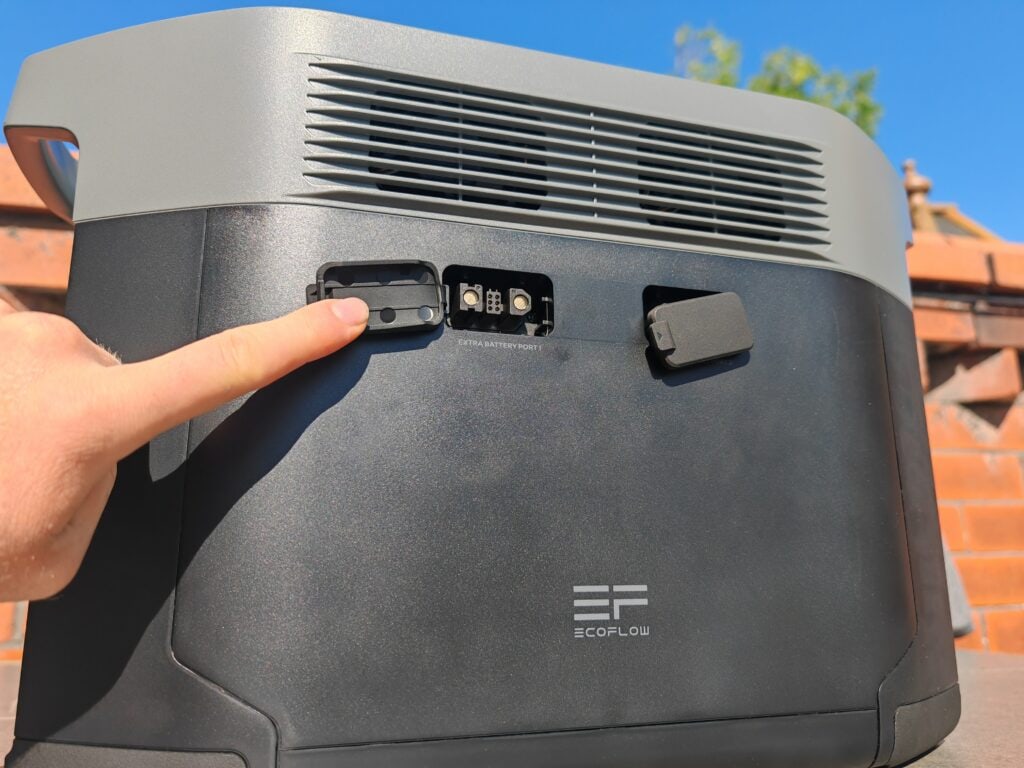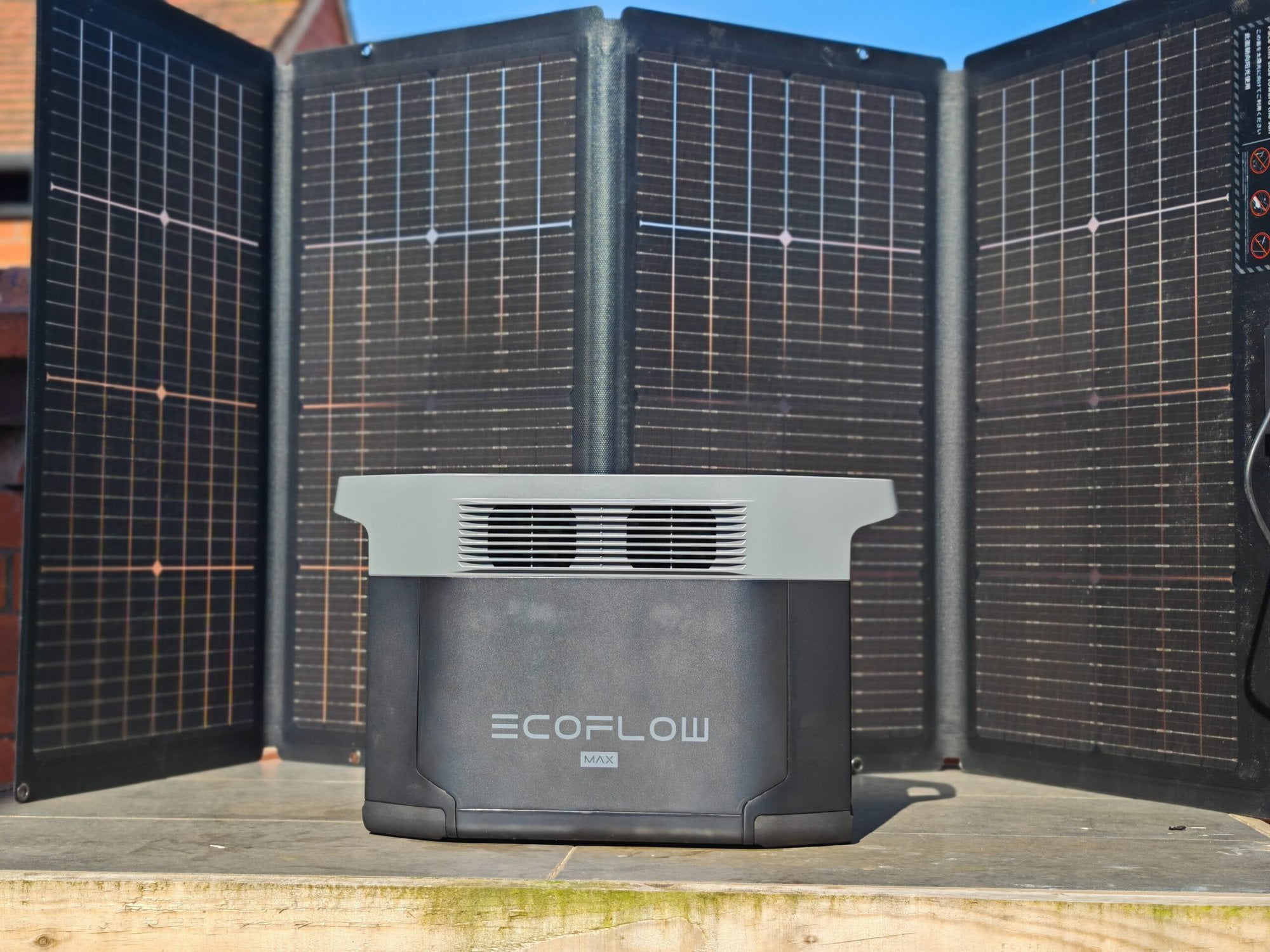Any links to online stores should be assumed to be affiliates. The company or PR agency provides all or most review samples. They have no control over my content, and I provide my honest opinion.
I have previously reviewed the EcoFlow Delta 2 portable power station, and it is probably my favourite portable power station I have reviewed.
The normal Delta 2 is a 1024Wh power station with a maximum output of 1800W total (Surge 2700W) with four AC outlets. It can then run devices up to 2400W using the X-Boost function.
The new EcoFlow Delta 2 Max doubles that capacity to 2048 Wh and increases the output to 2400W total (Surge 4800W) while keeping the same four AC outlets. This then has an X-Boost power of up to 3100W.
| Preview | Product | Rating | Price | |
|---|---|---|---|---|

| ECOFLOW DELTA 2 Max Portable Power Station, Expandable... | £999.00 | Buy on Amazon |
EcoFlow Delta 2 Max vs Delta 2 vs Jackery Explorer 2000 Pro Specification


| EcoFlow | Delta 2 Max | Delta 2 | Explorer 2000 Pro |
|---|---|---|---|
| Capacity | 2048 Wh | 1024 Wh | 2,160Wh |
| Extra Battery | 2x DELTA 2 Max Smart Extra Batteries / DELTA Max Smart Extra Battery | 1x DELTA 2 extra battery / DELTA Max extra battery | N/A |
| AC Output | 4 outlets, 2400W total (Surge 4800W) | 4 outlets, 1800W total (Surge 2700W) | 230V, 50Hz, 2,200W (4,400W Peak) |
| Max Device(s) Power (with X-Boost) | X-Boost 3100W | 2400W | 2,200W |
| USB-A Output | 2 ports, 5V, 2.4A, 12W Max per port | 2 ports, 5V, 2.4A, 12W Max | |
| USB-A Fast Charge | 2 ports, 5V, 2.4A / 9V, 2A / 12V, 1.5A, 18W Max | 2 ports, 5V, 2.4A / 9V, 2A / 12V, 1.5A, 18W Max | 2x Quick Charge 3.0×2, 18W Max |
| USB-C Output | 2 ports, 5/9/12/15/20V, 5A, 100W Max per port | 2 ports, 5/9/12/15/20V, 5A, 100W Max | 2x 100W Max, (5V, 9V, 12V, 15V, 20V up to 5A) |
| Car Power Output | 1 port, 12.6V, 10A, 126W Max | 1 port, 12.6V, 10A, 126W Max | |
| DC5521 Output | 2 ports, 12.6V, 3A, 38W Max per port | 2 ports, 12.6V, 3A, 38W Max | N/A |
| Mains Charging | X-stream Fast Charge 2300W, 10A | 1200W | 11V-17.5V, 8A Max, Double to 8A Max 17.5V⎓60V, 12A Double to 24A/1400W Max |
| AC Input Voltage | 220- 240 V~ max. 10A 50/60 Hz | 120V, 60Hz, 15A Max | |
| Solar Charging | 11-60V 15A, single port 500W; dual port 1,000W | 11-60V, 15A, 500W max | Up to 1200 with 6xSolar Saga 200 |
| Car Charging | Support 12V/24V battery, 8A | Support 12V/24V battery, 8A | 12V⎓10A |
| Battery Chemistry | LFP (LiFePO4 battery) | LFP (LiFePO4 battery) | Lithium-ion |
| Cycle Life | 3000 cycles to 80+% capacity | 3000 cycles to 80+% capacity | 1000 cycles to 80%+ capacity |
| Connectivity | Wi-Fi & Bluetooth | Wi-Fi & Bluetooth | N/A |
| Dimensions | 497 × 242 × 305 mm /19.6 × 9.5 × 12 in | 15.7 x 8.3 x 11 in / 400 x 211 x 281 mm | 384mmx269mmx308mm |
| Net weight (kg) | 23 kg | 12 kg | 19.5kg |
As I have reviewed both the Delta 2 and Jackery Explorer 2000 Pro, I made a comparison of the specification. The Jackery Explorer 2000 Pro is the highest capacity power station I have reviewed to date and the closest in comparison to the EcoFlow Delta 2 Max.
It is worth noting that Jackery recently launched the Jackery Solar Generator 2000 Plus, which is their first power station to implement LiFePO4 batteries and has a lifecycle of 4000 cycles to 70%+ capacity.
EcoFlow Delta 2 Max Expansion

The Delta 2 Max, by itself, has 2048 Wh of power. You can then pair this up with up to two additional Delta 2 Max Smart Extra batteries, which each have a capacity of 2046Wh. So with the three batteries, you’d have a total capacity of 6144Wh.
Each smart extra battery has an RRP of £1,349.
You can buy the EcoFlow Delta 2 Max + one smart extra battery for £3,248.
EcoFlow Delta 2 Max Balcony Solar System
EcoFlow recently announced the new balcony solar system, which is a sort of DIY home solar panel system solution. It works with most of the EcoFlow portable power stations, but the EcoFlow Delta 2 Max is an ideal power station for this system due to its high capacity and high power outputs.
I will hopefully be reviewing this system in the coming weeks, but here is a quick overview of the system:
This system stores all excess energy in a portable power station during the daytime and gives it back to you whenever you need it
EcoFlow claims:
With up to 1039kWh feeding into your home per year, you can save a maximum sum of €415. And your energy bill savings are 3.5 times as much as that from using other home solar systems without batteries.
For the UK, if you did collect 1039kWh of solar energy, that would work out at £311.70 based on the July price cap of £0.30 per kWh of electricity.
The new EcoFlow PowerStream Microinverter is the basis of this system, and it basically acts like a hub which has inputs for the portable power station, solar panels and the AC port.
It is designed to be a tool-free installation, and they even have a super flat solar cable which allows you to wire up your solar panels with minimum effort.
You pair this up with the 100W and 400W Rigid Solar Panels with a maximum 800W solar input supported.
You can then pair that up with the two Extra Batteries for up to 6kWh of home backup.
This system is designed to work best with the new EcoFlow smart plugs. The smart plugs monitor appliances’ energy consumption in real-time, so the microinverter can allocate just the right amount of electricity to each appliance, and the surplus to a portable power station. During peak hours, it prioritises home use. And most of the energy gets stored in off-peak times.
Overall, it sounds like an interesting and innovative system that I am eager to try out.
EcoFlow Delta 2 Max Design & Port Configuration

The basic design is the same as the existing EcoFlow Delta 2. It is just physically larger.
The various outputs are on the left and right side, with four UK AC socks, the solar input and 12V ports on one side, then the four USB-A ports, two USB-C ports, and display on the other.
On the rear of the power station, there are two extra battery ports vs the one on the Delta 2.
You also get the same two carry handles, and considering this weighs over 20 kg, you will probably need them.

EcoFlow App






Like all EcoFlow products I have received, the Delta 2 Max can connect to WiFi and has an app allowing you to control the settings.
It is not something you need to use a lot, but it has some useful features. The main screen allows you to see the current input/output, and this provides is helpful for indicating how long the charge will last or how long it will take to charge.
Under the settings menu, you can customise various features, such as setting the X-boost and car input power.
With my previous EcoFlow reviews, I was able to set the AC charge speed, but this doesn’t seem to be possible with this. This could be handy if you want to do a slow charge and reduce the chance of the fans kicking in.
Under labs and automation, you have some settings that allow you to set schedules where the unit will stay active. This seems ideal for the balcony solar system, as you can set the AC to charge overnight if you have off-peak rates, or alternatively, there are solar charging and AC discharging schedules.
EcoFlow Delta 2 Max Charging
Solar Charging
I was fortunate enough to receive this in the middle of our recent heatwave. I haven’t had a chance to take this away with me yet and haven’t used it with the fixed 400W panels as part of the balcony solar system yet.
But I did use it with the superb EcoFlow 220W bifacial solar panel. I live in Blackpool, so leaving over £2k worth of batteries and solar panels out in my front garden is sadly not a possibility, but I did get to use it in my back garden. It is not an ideal position, being a small garden that’s northerly facing, but I still managed to get good results thanks to the sunny weather.
I saw up to 190W solar input and was able to charge the power station from 30% to 60% over the space of a few hours. While that may not sound overly impressive, with 200W of consistent input, it would take 10 hours to charge fully.
AC Charging / Fan Noise

With AC charging, it takes a little while for the power station to go up to the full 2300W input, and after a short while at 2300W, you will hear the fans kick in. The fan noise isn’t great, it is not particularly loud, but there is a bit high pitched which I find annoying. Playing music in my office easily drowns it out, but it could be intrusive in some living arrangements.

EcoFlow Delta 2 Max Performance

The Ecoflow Delta 2 Max portable power station can put out 2400W of power with a surge output of 4800W. You can extend the power to 3100W using X-boost.
The inverter itself can only do 2400W; the X-Boost function regulates the voltage down for higher power down, allowing you to run a 3100W device at 2400W, whereas most other power stations would run for a few seconds before the surge protection kicks in. This would obviously reduce the performance of the device in question. For example, a kettle will take longer to boil. Similarly, some devices will just not work, but they have strict voltage requirements.
With it being so hot when I received this, I used the opportunity to crack out my EcoFlow Wave 2 portable AC to cool my bedroom. That has its own battery, but I left that disconnected and plugged it directly into the Delta 2 Max.
The Wave 2 doesn’t use anywhere near what the Delta 2 Max two is capable of outputting. When I checked the app, I would typically see about 300-350W of output with the AC set to max and the temperature set to 16°C, which would work out at a bit less than 2 hours of use from the solar energy I collected during the day and another couple of hours from charge the power station already had.
At 2400W, I this has the output to power almost anything. A normal kettle will go up to 3kW, and with the X-boost, you can still use one of these. Looking at the smart meter in my home, as long as I am not cooking, the power draw of my whole home typically stays under 1kW.
USB Ports
The other main ports I used were the USB. With these, you have two 12W USB-A ports, two 18W fast charge USB-A ports, and then two 100W USB-C ports.
With so many devices being USB-C now, I feel like the port configuration could be better, but the competing solutions all have similar, or worse, configurations.
I tested both the USB-C ports charging up my Anker 737 Power Bank and can confirm they both hit 100W without an issue,
Price and Alternative Options
| Preview | Product | Rating | Price | |
|---|---|---|---|---|

| ECOFLOW DELTA 2 Max Portable Power Station, Expandable... | £999.00 | Buy on Amazon |
The EcoFlow Delta 2 Max is priced at £1,899 then the additional smart batteries are £1,349.
The EcoFlow Delta 2, has half the capacity as an RRP of £1100 but is available for £900.
The older EcoFlow Delta Max is available in two capacities:
- 1600: £1,349
- 2000: £1,499
Then the top of the range 3600Wh Delta Pro is £2,999
The new Jackery Explorer 2000 Plus is £1,999, which has a similar specification, and this can also be expanded with additional batteries priced at £1,399.
Bluetti has the AC200P, which is also 2,000Wh. The overall spec isn’t quite as good, but it is priced attractively at £1,399 (RRP £1800), or they have the AC200MAX, which is closer in spec to the Jackery and EcoFlow and priced at £1,499 (RRP £2100)
Anker has the Solix F2000 (PowerHouse 767), which is £2,199 RRP and £210 available at the time of writing.
Overall
I loved the original Delta 2 power station, and I have been using it since I reviewed it back in September 2022.
The EcoFlow Delta 2 Max is mostly the same but twice the capacity, with much higher maximum output and better expansion. I, therefore, also love this.
I have been very happy with all the Ecoflow products. I think all the big brands doing power stations are excellent in their own right, so I wouldn’t say any are objectively better than the others, but I do find myself using Ecoflow products more than the other brands I have available.
While it is easy to think bigger equals better, you will obviously need to factor in how you plan to use this. At 20 kg, it is not really something you are carrying everywhere with you and perhaps not the ideal portable power station for the occasional weekend camping trip.
I personally have a small car, don’t really go camping, and it is a bit too big to use on my mother’s canal boat. So for me, it is not hugely useful as a portable power station.
For me, this will be used as a home backup solution. I am hoping to review the Balcony Solar System, and when I do, I will likely try and run all the electrics in my gym/garage with it, and I will quite likely relocate a server, NAS drive, and NVR into my shed and have all that running off it. It may not be completely off-grid, but during the summer months, it should be powered mostly by solar.
I also have a friend that also uses a power station in a garage, which lacks mains power, and he uses it to run power tools.
EcoFlow Delta 2 Max Portable Power Station Review
Summary
The EcoFlow Delta 2 Max is an awesome high-capacity high-powered power station. The size and weight limit how portable it is, but this is perfect as a home backup power solution (or used as part of the balcony solar system).
Overall
90%-
Overall - 90%90%
Pros
- Massive capacity
- 2400W output with 3100W X-boost means you can power pretty much anything
Cons
- Fan noise while AC charging can be annoying
I am James, a UK-based tech enthusiast and the Editor and Owner of Mighty Gadget, which I’ve proudly run since 2007. Passionate about all things technology, my expertise spans from computers and networking to mobile, wearables, and smart home devices.
As a fitness fanatic who loves running and cycling, I also have a keen interest in fitness-related technology, and I take every opportunity to cover this niche on my blog. My diverse interests allow me to bring a unique perspective to tech blogging, merging lifestyle, fitness, and the latest tech trends.
In my academic pursuits, I earned a BSc in Information Systems Design from UCLAN, before advancing my learning with a Master’s Degree in Computing. This advanced study also included Cisco CCNA accreditation, further demonstrating my commitment to understanding and staying ahead of the technology curve.
I’m proud to share that Vuelio has consistently ranked Mighty Gadget as one of the top technology blogs in the UK. With my dedication to technology and drive to share my insights, I aim to continue providing my readers with engaging and informative content.
Last update on 2025-07-02 / Affiliate links / Images from Amazon Product Advertising API







